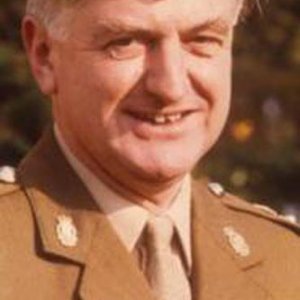- SURNAME
Styles
- FORENAME
Stephen George
- UNIT
321 EOD Unit, Royal Army Ordnance Corps
- RANK
Major
- NUMBER
383996
- AWARD
George Cross
- PLACE
Northern Ireland 1971
- ADDITIONAL INFORMATION
born 16.3.1928 Crawley, Sussex
educated Collyers Grammar School, Horsham, Sussex
National Service 1946
officer cadet training
commissioned RAOC 1947
Central Ammunition Depot,Kineton
Regular Commission 1949
RAOC
1 Bn King's Own Yorkshire Light Infantry
Mention in Despatches (for Malaya)
graduated Royal Military College of Science
28th Commonwealth Brigade Ordnance Field Park Regiment (Malaya)
1 Corps, BAOR
RAOC 1960s
Lt Colonel 1972
Chief Ammunition Technical Officer, British Army 1972
retired 1974
advisor on anti-terrorist techniques
author "Bombs Have No Pity" 1978
married Mary Rose Woolgar 1950 (3 children)
died 1.8.2006
London Gazette 45569, 10th January 1972, Page 347
- OBITUARY
CITATION:
George Cross : As Senior Ammunition Technical Officer, Northern Ireland, Major Styles was responsible for the supervision of the Explosive Ordnance Disposal teams in the Royal Army Ordnance Corps deployed to deal with the ever-increasing number of explosive devices used in the terrorist campaign.
On 20th October 1971, Major Styles was called to assist with a device of an apparently new design placed in a public telephone kiosk in Belfast's comparatively new, and largest, hotel, the Europa. Major Styles immediately went to the scene and, having ensured that the military and police had secured the area and evacuation of personnel had also been effected, took charge of the operation of neutralising, removing and dismantling the bomb.
Investigation revealed that the bomb was of a new and complicated construction with anti-handling devices to defeat attempts to disarm it. Until the electrical circuit had been neutralised, the slightest movement could have set it off. The device contained between 10 and 15 Ibs. of explosive and could have caused instant death as well as extensive damage. No-one was more aware of the destructive capability of the bomb than Major Styles, yet he placed himself at great personal risk to minimise the danger to his team, to confirm the success of each stage of the operation, and to ensure the practicability of the next stage. The whole operation took seven hours to plan and execute and was completely successful.
Two days later he was again called to the same hotel where a second bomb had been laid by armed terrorists. This bomb was found to be an even
larger device with a charge of over 30 Ibs. of explosive, anti-handling devices, and a confusion of electrical circuits ; it was clearly intended to defeat disarming techniques and to kill the operator trying to neutralise it. Major Styles again immediately took charge of the situation and successfully disarmed, removed and dismantled the bomb, this time after 9 hours intense and dangerous work.
As a result of his courageous and dedicated resolution, two determined and ingenious attempts by terrorists against life and property were defeated, and technical information was obtained which will help to save the lives of operators faced with such devices in future.
Throughout each operation Major Styles displayed a calm resolution in control, a degree of technical skill and personal bravery in circumstances of
extreme danger far beyond that of the call of duty. His work was an outstanding inspiration and example, particularly to others engaged in this dangerous type of work.
On 20th October 1971, Major Styles was called to assist with a device of an apparently new design placed in a public telephone kiosk in Belfast's comparatively new, and largest, hotel, the Europa. Major Styles immediately went to the scene and, having ensured that the military and police had secured the area and evacuation of personnel had also been effected, took charge of the operation of neutralising, removing and dismantling the bomb.
Investigation revealed that the bomb was of a new and complicated construction with anti-handling devices to defeat attempts to disarm it. Until the electrical circuit had been neutralised, the slightest movement could have set it off. The device contained between 10 and 15 Ibs. of explosive and could have caused instant death as well as extensive damage. No-one was more aware of the destructive capability of the bomb than Major Styles, yet he placed himself at great personal risk to minimise the danger to his team, to confirm the success of each stage of the operation, and to ensure the practicability of the next stage. The whole operation took seven hours to plan and execute and was completely successful.
Two days later he was again called to the same hotel where a second bomb had been laid by armed terrorists. This bomb was found to be an even
larger device with a charge of over 30 Ibs. of explosive, anti-handling devices, and a confusion of electrical circuits ; it was clearly intended to defeat disarming techniques and to kill the operator trying to neutralise it. Major Styles again immediately took charge of the situation and successfully disarmed, removed and dismantled the bomb, this time after 9 hours intense and dangerous work.
As a result of his courageous and dedicated resolution, two determined and ingenious attempts by terrorists against life and property were defeated, and technical information was obtained which will help to save the lives of operators faced with such devices in future.
Throughout each operation Major Styles displayed a calm resolution in control, a degree of technical skill and personal bravery in circumstances of
extreme danger far beyond that of the call of duty. His work was an outstanding inspiration and example, particularly to others engaged in this dangerous type of work.
WEB LINKS:
• https://www.thegazette.co.uk/London/issue/45569/supplement/347FINDAGRAVE:
https://www.findagrave.com/memorial/128691009/stephen-george-styles
Last edited by a moderator:






